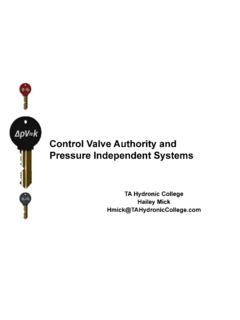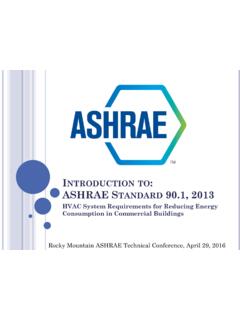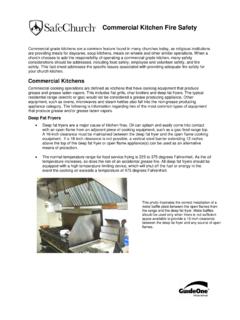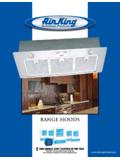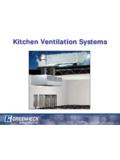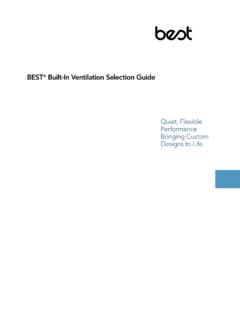Transcription of ASHRAE - Energy Efficient Kitchen Design
1 Energy Efficient Kitchen Ventilation Design1 Tyler SchillingGreenheck Fan CorporationLearning Objectives Kitchen Design objectives Kitchen control technology DCV application and design2 Design Objectives Comply with local and industry codes IMC Section 507 Commercial Kitchen Hoods NFPA 96 - Standard for Ventilation Control and Fire Protection of Commercial Cooking Operations ASHRAE - Energy Standard for Buildings Minimize Kitchen exhaust hoods shall comply with the requirements of this section. Hoods shall be Type I or Type II and shall be designed to capture and confine cooking vapors and :1. Factory-built commercial exhaust hoods which are tested in accordance with UL 710, listed, labeled and installed in accordance with Section shall notbe required to comply with Sections , , , , , Section 507 Commercial Kitchen Hoods45 Scope of UL These requirements cover exhaust hoods intended for placement over commercial cooking equipment.
2 Exhaust hoods with and without exhaust dampers are covered by these requirements. All exhaust hoods are intended for use with fire extinguishing system units. notbe required to comply - Type I - hood joints, seams and - Grease - Canopy size and - Capacity of Non-canopy size and - Exhaust outletsIMC Section 507 Commercial Kitchen Hoods Factory-build Kitchen exhaust hoods which are tested in accordance with UL 71067 Capacity of Hoods *Commercial food service hoods shall exhaust a minimum net air in accordance with this section and section through The net quantity of exhaust air shall be calculated by subtracting any airflow supplied directly to a hood cavity from the total flow rate of a hood . Where any combination of heavy-duty, medium-duty and light-duty cooking appliances are utilized under a single hood , the exhaust rate required by this section for the heaviest duty appliance covered by the hood shall be used for the entire Using IMCCFM = (Exhaust Rate) (Linear Foot of hood )Exhaust rates:Light-duty 200 cfm/ln.
3 Ft (Ovens, steamers, kettles)Medium-duty 300 cfm/ln. ft (Electric ranges, griddles, fryers) Heavy-duty 400 cfm/ln. ft (Gas ranges, broilers, woks)Extra heavy-duty 550 cfm/ln. ft (Solid fuel cooking) The above are for wall canopy hoods Char-broiler = Heavy-duty (400 cfm per linear foot)400 cfm/ln. ft x 8 ft = 3,200 cfm9 Calculation Using IMC10 Alternate Calculation ExampleManufacturer Method Total required exhaust must equal contaminated airflow plus a minimum capture airflowQC= Contaminated air generated by the cooking equipmentQF= Quantity of air to contain surges, cross drafts and QC+ QF11 Exhaust Air Volume Cooking appliances can be grouped into the following general categories, based upon Thermal Updraft Velocity characteristics: Light-duty (ovens, steamers, ranges)50 fpm Medium-duty (griddles, fryers)85 fpm Heavy-duty (char-broilers)150 fpm Extra Heavy-duty (solid fuel)185 fpm12Qc Contaminated Air Quantity13 Typical Equipment BatteryEquipmentDimensionsArea (ft2)Updraft Velocity FactorContaminated Air (CFM)Gas Range24 x Char-Broiler30 x Griddle30 x Airflow =179014 Exhaust Volume Calculating QFTotal hood Area (96 x 40) / 144 = sq.
4 Ft(Total hood Area - Total Appliance Area) x 50QF= ( ) x 50 = 417 cfmTotal Exhaust Airflow QE= 1790 (QC) + 417 (QF) = 2,207 cfmMethodExhaust CFMIMC3,200 Manufacturer Method2,207 Save on required exhaust rates by using manufacturer methods15 Comparison16 Kitchen Control Technology16 Constant Volume Control System enable Switch Temperature interlock Single speed Airflow determined by IMC or manufacturer method17 Two Speed Systems Poor man s demand control High cost two speed motor Manual control required Over/Under ventilation1819 Demand Control Ventilation Provide the correct level of ventilation for the actual cooking load Modulate exhaust fan(s) and supply fan(s) General. Commercial Kitchen exhaust hoods shall comply with the requirements of this section. Hoods shall be type 1 or type 2 and shall be designed to capture and confine cooking vapors and :1.
5 Factory built commercial exhaust hoods which are built commercial cooking recirculating systems3. Net exhaust volumes for hoods shall be permitted to be reduced during no load cooking conditions, where engineered or listed multi-speed or variable speed controls automatically operate the exhaust system to maintain capture and removal of cooking effluents as required by this Made to IMC 2003 (Current in 2010)IMC 2003 Edition2021 ASHRAE and Demand-Controlled Ventilation (DCV) Systems for KitchensASHRAE adopts new language regarding demand-based ventilation system(s) for kitchens. Section states the following: If a Kitchen /dining facility has a total Kitchen hood exhaust airflow rate greater than 5,000 cfmthen it shall have one of the following: At least 50% of all replacement air is transfer air that would otherwise be exhausted. In most applications, the transfer air would be from a rooftop unit in an adjacent dining area.
6 Demand ventilation system(s) capable of at least 50% reduction in exhaust and replacement air system airflow rates, including the controls necessary to modulate airflow in response to appliance operation. ASHRAE for the Design of high-performance green buildings Section Variable Speed Fan Control In addition to the requirements in [ ASHRAE ] Standard , commercial Kitchen type I and type II hoods shall have variable speed control for exhaust and make-up air fans to reduce hood airflow rates at least 50%during those times when cooking is not Not all manufacturers meet this requirement!22 airflow air velocity The air velocity through any duct shall be not less than m/min (500 ft / min) NFPA 96 Grease Duct23 NFPA 96 2008 Edition24 ASHRAE ResearchTest Results Duct Flux, g/ft Duct Velocity, fpmBottomSidesTop Temperature Based Temperature and Optics basedVariable Volume Systems25 Variable Volume Options Temperature Based Temp Sensors monitor heat High Heat Applications Optics Based Temp Sensors Optic Sensors Low Heat/High Steam Applications26 Variable Volume User Interface Keypad with LCD display Controls fans and lights Most Common Touch screen Independent light and fan control Live system operation dashboard to monitor Energy savings27 Variable Volume and BMS Building management system interfacing LONworks BACnet MSTP BACnet IP Modbus28 Variable Volume with EC Motors (ECMs)
7 EC motors are compatible with the VAV system Eliminates the need for a variable frequency drive Provides additional electrical motor Energy savings of 20-70% Eliminates belt maintenance29 Proportional tracking Based on the weighted average speeds of the exhaust fans Issues Forward curve vs. backward incline wheels on exhaust and supply fans Direct gas make-up airSupply Fan Control33 Supply Fan Control Static pressure Based on building static pressure between the Kitchen and dining room (adjacent space) Based on building static pressure between the Kitchen and the outside34In our world of automation, Kitchen ventilation systems are operating in the dark ages Would you buy a car without a throttle? Would you buy a house without a thermostat? 35 DCV Benefits3637 Variable Volume Systems Monitors cooking activity and matches airflow to the cooking loadEnergy Savings Increases overall hood efficiency by up to 20-50% Fan Energy savings: 50% speed reduction = 88% savings Conditioned air savings: $1-$3/cfm per year Payback.
8 1-3 years depending on system38 Savings - Example39 Airflow3,000 CFMO perating15 hours per dayCost of conditioning$3/cfm per year40% Reduction in airflow 1,200 cfmGenerates conditioned (H&C) air savings of $2,250 per yearBenefits Reduced electrical costs Exhaust and supply fan motors Reduced heating and cooling costs The majority of the Energy saving is in the conditioned air Low fan maintenance Prolonged equipment life VFD soft start Enhanced employee comfort Reduced fan noise40 Benefits Serves as IMC 2006 section compliant device hood and appliance interlock Potential to contribute toward LEED credits Innovation and Design Optimize Energy performance Many states offer rebates to owners for purchasing and installing variable volume systems41 Ideal DCV Applications Over 12 operating hours per day Hoods over 8 feet long Variable cooking loads throughout day Areas with high gas and/or electric rates 4243 Other Energy Saving Options44 LightingExample.
9 50 foot-candles 9 x 4 hood 14 hours a day $ kWhIncandescent Lights6 Lights (100 W bulbs)Cost/yr. = $ Fluorescent (CFL)6 Lights (26 W bulbs)Cost/yr. = $ 1 - 3 Light Fixture (2 - 32 W lights)Cost/yr. = $ lights1 - 3 LED Fixture (2 18 W lights)Cost/yr. = $ Considerations Attention must be given to all building sources of outside air Dining room RTU (economizers) Kitchen make-up air Minimum airflow requirements for gas fired make-up air and cooling coils Furnace turn-down (temperature rise) Independent fan for each hood Allows for increased savings Side skirts Allows for slightly lower airflows45 Design Considerations Supply lower velocity make-up air from multiple sources When the supply limit is reached on the hood supply plenum, add perforated ceiling diffusers for the remainder Use ASP/Perimeter supply on three sides of hood Use face supply with perforated ceiling diffusers Use back supply/rear discharge with face supply hood46 Thank you for your mission of Greenheck is to be the market leader in the development, manufacture and worldwide sale of quality air moving and control equipment with total commitment to customer service.

